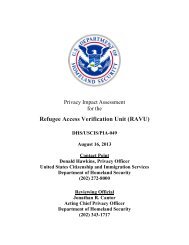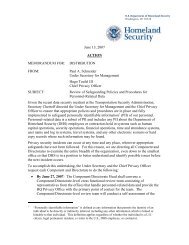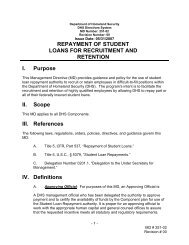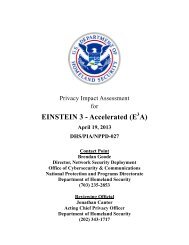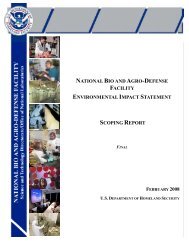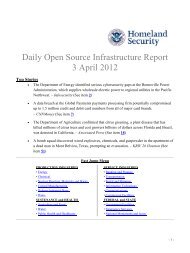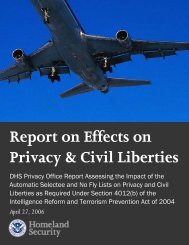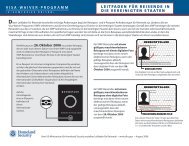Exodus Accountability Referral System (EARS) - Homeland Security
Exodus Accountability Referral System (EARS) - Homeland Security
Exodus Accountability Referral System (EARS) - Homeland Security
Create successful ePaper yourself
Turn your PDF publications into a flip-book with our unique Google optimized e-Paper software.
Privacy Impact Assessment<br />
for the<br />
<strong>Exodus</strong> <strong>Accountability</strong> <strong>Referral</strong> <strong>System</strong><br />
(<strong>EARS</strong>)<br />
May 6, 2010<br />
Contact Point<br />
James Dinkins<br />
Director, Office of Investigations<br />
U.S. Immigration and Customs Enforcement<br />
(202) 732-5100<br />
Reviewing Official<br />
Mary Ellen Callahan<br />
Chief Privacy Officer<br />
Department of <strong>Homeland</strong> <strong>Security</strong><br />
(703) 235-0780
Abstract<br />
Privacy Impact Assessment<br />
ICE, <strong>Exodus</strong> <strong>Accountability</strong> <strong>Referral</strong> <strong>System</strong><br />
Page 2<br />
In order to enforce U.S. federal export control laws, U.S. Immigration and Customs Enforcement<br />
(ICE) and U.S. Customs and Border Protection require information from federal regulatory agencies that<br />
grant export licenses on controlled items, specifically whether a license is required and whether a license<br />
has been granted. The ICE <strong>Exodus</strong> Command Center operates the <strong>Exodus</strong> <strong>Accountability</strong> <strong>Referral</strong><br />
<strong>System</strong>, an ICE database that initiates, tracks, and manages requests to regulatory agencies for this<br />
information. The purpose of this Privacy Impact Assessment (PIA) is to document the system’s collection<br />
and use of personally identifiable information (PII).<br />
Overview<br />
The <strong>Exodus</strong> <strong>Accountability</strong> <strong>Referral</strong> <strong>System</strong> (<strong>EARS</strong>) is owned by the ICE Office of<br />
Investigations. <strong>EARS</strong> is an intranet-based tool that supports efforts by ICE and U.S. Customs and Border<br />
Protection (CBP) to enforce U.S. federal export control laws, including the Arms Export Control Act and<br />
the Export Administration Act. Only ICE and CBP personnel have direct access to <strong>EARS</strong>.<br />
Many commodities and services 1 require licenses in order to be exported from the United States.<br />
The authority to license the export of these commodities and services rests with a number of federal<br />
regulatory agencies, such as the Department of State’s Directorate of Defense Trade Controls, which<br />
licenses military use items such as missile systems and grenades and the Commerce Department’s Bureau<br />
of Industry and <strong>Security</strong> which licenses dual use items such as civilian aircraft and tooling machines.<br />
Criminal enforcement of violations of these export laws falls primarily to ICE and CBP. ICE special<br />
agents initiate criminal investigations into possible export violations, as well as make arrests and obtain<br />
indictments for export-related criminal violations. In addition, ICE and CBP conduct thousands of<br />
seizures of arms, military weaponry, and other sensitive commodities related to illegal export schemes.<br />
These efforts significantly contribute to preventing sensitive U.S. technologies and weapons from<br />
reaching the hands of terrorists, hostile countries, and violent criminal organizations.<br />
During the course of law enforcement investigations or border enforcement activities, ICE agents<br />
and CBP officers may identify potential violations of U.S. export control laws. To determine whether the<br />
export of a particular commodity, service, or brokering activity 2 is controlled, ICE and CBP must consult<br />
with the relevant federal regulatory agency (hereafter, licensing agency). Those agencies will advise<br />
whether the commodity, service or brokering activity at issue is “export controlled” (i.e., whether an<br />
1 “Services” is defined as the furnishing of assistance (including training) to foreign persons, whether in the United<br />
States or abroad in the design, development, engineering, manufacture, production, assembly, testing, repair,<br />
maintenance, modification, operation, demilitarization, destruction, processing or use of licensable for export<br />
commodities. An example of a service that would require an export license is providing maintenance, design, or<br />
training support for an export controlled commodity such as a missile system.<br />
2 Brokering activity” is defined as acting as a broker and includes the financing, transportation, freight forwarding,<br />
or taking of any other action that facilitates the manufacture, export, or import of a defense article or defense<br />
service, irrespective of its origin.
Privacy Impact Assessment<br />
ICE, <strong>Exodus</strong> <strong>Accountability</strong> <strong>Referral</strong> <strong>System</strong><br />
Page 3<br />
export license is required), and whether a license has been granted. ICE and CBP request this information<br />
from licensing agencies using <strong>EARS</strong> to initiate, track, and manage the request. These requests for<br />
information are called referrals.<br />
An ICE agent or CBP officer creates a referral by entering information into <strong>EARS</strong> about the<br />
commodity, service, or brokering activity in question along with identifying information about the<br />
Principal Party in Interest, which is typically a business entity or individual who is a registered importer,<br />
exporter, or broker. Then a manager in the ICE <strong>Exodus</strong> Control Center (ECC) must review and approve<br />
the referral in <strong>EARS</strong>. ECC personnel will print out the approved referral from <strong>EARS</strong> and send to the<br />
licensing agency in paper form or will email it in electronic form. The <strong>EARS</strong> database assigns a unique<br />
identifier to each referral for tracking purposes.<br />
The licensing agencies that receive referrals through <strong>EARS</strong> are:<br />
Department of State (DOS) Directorate of Defense Trade Controls - Controls exports of<br />
single-use military components and services<br />
Department of the Treasury Office of Foreign Assets Control - Administers embargoes<br />
and sanctions (Iranian embargo)<br />
Department of Commerce (DOC) Bureau of Industry and <strong>Security</strong> - Controls exports of<br />
dual-use components (dual-use components are items that have both military and civilian<br />
uses)<br />
Department of Justice (DOJ) Bureau of Alcohol Tobacco, Firearms and Explosives<br />
(ATF) - Controls imports of firearms<br />
Department of Energy (DOE) Nuclear Regulatory Commission (NRC) - Controls exports<br />
of goods used in nuclear reactors<br />
The most common types of referrals are:<br />
License Determination. This is a request for a determination by the licensing agency as<br />
to whether an export of a commodity or service would require a license.<br />
License History. This is a request for information on whether a particular individual or<br />
company has registered or obtained any licenses from a licensing agency.<br />
License Verification. This is a request for a check on a particular license number to<br />
determine if it is valid, expired, or counterfeit.<br />
Government Jurisdiction. This initiates a review by licensing agencies of a particular<br />
commodity or service in cases where a commodity or service may be subject to the<br />
authority or jurisdiction of more than one licensing agency. The licensing agencies will<br />
make a final determination about which agency has ultimate jurisdiction.<br />
Pre-trial and Trial Certification. This is a request for an in-depth examination by the<br />
licensing agency of a commodity, service, or brokering activity to verify the agencies<br />
jurisdiction prior to an indictment, plea agreement, or judicial proceeding. Pre-trial
Privacy Impact Assessment<br />
ICE, <strong>Exodus</strong> <strong>Accountability</strong> <strong>Referral</strong> <strong>System</strong><br />
Page 4<br />
Certifications verify whether a commodity, service or brokering activity is within the<br />
jurisdiction of the International Traffic in Arms Regulations and the Arms Export Control<br />
Act, 3 while Trial Certifications involve a DOS Directorate of Defense Trade Controls<br />
commodity that reaches the stage of a trial and has an actual trial date.<br />
Licensing agencies send responses to the ECC by mail, fax, or email. ECC personnel scan and<br />
upload the responses into <strong>EARS</strong> with the information received from licensing agencies, including the<br />
agencies’ determinations on whether or not an item in question is controlled and, if so, under what<br />
authority and on the existence or histories of licenses. ECC personnel perform these tasks for both ICE<br />
and CBP <strong>EARS</strong> matters. Information about or responses to <strong>EARS</strong> referrals are also captured in the TECS<br />
system. 4 ICE agents include this information in their reports of investigation (ROIs), which are saved to<br />
the ICE case management system within TECS. 5 CBP officers include this information in the narrative<br />
section of the seizure report they file in TECS. Paper copies of the responses are most often kept in the<br />
investigation or seizure file. The responses from the licensing agencies may be used as evidence in court<br />
procedures and become part of court records.<br />
<strong>EARS</strong> data includes contact and identification information about ICE agents, CBP officers and<br />
other ECC personnel, information pertaining to the various types of referrals described above, descriptive<br />
and technical information on export items, as well as information about suspected violators (hereafter,<br />
“Principal Party in Interest”) in question.<br />
For access to <strong>EARS</strong>, authorized personnel must first establish a user account, as well as provide<br />
identification and contact information, such as name telephone number(s), email address, and office/port<br />
location. All users access <strong>EARS</strong> through the Visual Investigation and Intelligence <strong>System</strong> (VIIS), a<br />
portal through which ICE personnel can access various investigative software applications. This system<br />
provides user profile management and requires users to read and acknowledge the rules of behavior for<br />
systems linked to VIIS, such as <strong>EARS</strong>. Once users log in to VIIS, they are able to access <strong>EARS</strong> without<br />
an additional login.<br />
Only ICE Special Agents and CBP Officers, <strong>System</strong> Administrators, and ECC Program Managers<br />
have access to <strong>EARS</strong>. Only ECC Program Managers and the agent or officer requesting information have<br />
full read/write access to the information related to a specific referral in <strong>EARS</strong>. ICE and CBP users have a<br />
“view only” option for closed referrals that they may use to view records when conducting criminal<br />
investigations and inspections. <strong>EARS</strong> does not interface with any other information systems.<br />
3<br />
Arms Export Control Act, 22 U.S.C. § 2778 (2009); International Traffic in Arms Regulations, 22 C.F.R. §§ 120 –<br />
130 (2009).<br />
4<br />
See DHS/CBP-011 TECS <strong>System</strong> of Records Notice, Dec. 19, 2008, 73 FR 77778.<br />
5<br />
ICE’s investigative case records are maintained in the TECS system, but are covered by a separate Privacy Act<br />
<strong>System</strong> of Records Notice. See DHS/ICE-009 External Investigations <strong>System</strong> of Records Notice, Jan. 5, 2010, 75<br />
FR 404.
Section 1.0 Characterization of the Information<br />
Privacy Impact Assessment<br />
ICE, <strong>Exodus</strong> <strong>Accountability</strong> <strong>Referral</strong> <strong>System</strong><br />
Page 5<br />
1.1 What information is collected, used, disseminated, or<br />
maintained in the system?<br />
<strong>EARS</strong> collects and maintains PII about individuals who are the Principal Party in Interest into<br />
possible criminal violations of U.S. federal export control laws. The PII includes name, address, country<br />
of import, license type and number, and type of Principal Party in Interest. License type and number<br />
references various license classifications issued by the regulatory agencies. Each regulatory agency has<br />
different license types and its own numbering set that reference a particular type of export item. License<br />
types can refer to whether an export license is permanent or temporary, cleared for exporting classified or<br />
unclassified items or technical data, controlled substances, and other types of export items. The Principal<br />
Party in Interest type refers to whether the party is an exporter, manufacturer, or target of the<br />
investigation.<br />
<strong>EARS</strong> also collects and maintains information about the referral including type of request, date of<br />
request, associated case number and/or CBP violation code, type of transaction, previously submitted<br />
referral number(s), item or commodity (description, technical data, specifications, photographs),<br />
destination country, regulatory agency to which the referral is directed, agency determination,<br />
determination received date, and U.S. Munitions List category (if any).<br />
Licensing agencies that receive <strong>EARS</strong> requests send paper or email responses to the ICE ECC,<br />
which are uploaded into <strong>EARS</strong>. Depending upon the type of request, responses may include agencies’<br />
determinations on whether or not an item in question is controlled and, if so, under what authority,<br />
whether a license is required, the license numbers of existing licenses or past licenses, the U.S. Munitions<br />
List category (if applicable), and licensing officer name and title. This information is scanned by ICE<br />
ECC personnel and entered into <strong>EARS</strong>. In addition, <strong>EARS</strong> collects and maintains information about<br />
criminal or civil actions that result from the associated investigation or inquiry, including search warrant<br />
date, grand jury date, indictment date, plea date, conviction date, disbarment/sanction date and monetary<br />
penalty.<br />
<strong>EARS</strong> collects and maintains contact information for ICE agents/CBP officers, Licensing<br />
Officers, and U.S. Attorneys involved or related to the investigation or inquiry. The collected information<br />
consists of name, title, agency, office location, office code, e-mail address, cell/pager number, office<br />
telephone and facsimile number. <strong>EARS</strong> collects and maintains user account information on ICE and<br />
CBP personnel consisting of username, name, telephone number, cell/pager number, e-mail address,<br />
office code and location and assigned user role.<br />
Finally, <strong>EARS</strong> has the capability to produce a variety of summary reports for use by<br />
management, such as the number of requests for information submitted to licensing agencies, types of<br />
requests, and the number of requests that are pending a decision. These reports are used for internal<br />
management and statistical purposes only.
Privacy Impact Assessment<br />
ICE, <strong>Exodus</strong> <strong>Accountability</strong> <strong>Referral</strong> <strong>System</strong><br />
Page 6<br />
1.2 What are the sources of the information in the system?<br />
ICE agents and CBP officers gather information on items or commodities and suspected violators<br />
during the course of law enforcement investigations or law enforcement activities at ports of entry.<br />
Commodity information includes but is not limited to technical data, specifications, photographs of the<br />
item, and manufacturer’s certification forms. This information is usually obtained directly from a<br />
manufacturer or through Internet searches by agents or officers. ICE and CBP obtain relevant information<br />
from a number of other sources, such as business records and publicly available information from the<br />
Internet, to develop sufficient knowledge of the pertinent transaction, commodity, business entity or<br />
individual. This information is used by the licensing agencies to check against their records to determine<br />
if the Principal Party in Interest has the proper license/authorization to conduct the export activity in<br />
question.<br />
Federal licensing agencies that receive <strong>EARS</strong> referrals provide information based on their internal<br />
records on determinations on the need for licenses and information on licenses and licensing history in<br />
response to <strong>EARS</strong> referrals from ICE. Responses from the licensing agencies are scanned and uploaded<br />
into <strong>EARS</strong> by ICE ECC personnel for review by the requesting ICE agent and/or CBP officer.<br />
<strong>EARS</strong> itself is the source of statistical reports generated by the system.<br />
1.3 Why is the information being collected, used,<br />
disseminated, or maintained?<br />
ICE and CBP use the information that is collected through <strong>EARS</strong> to aid investigations and<br />
inquiries into criminal violations of U.S. federal export control laws. The data entered into <strong>EARS</strong> allows<br />
agents/officers to send queries to the federal agencies that grant licenses to importers, exporters, and<br />
brokers to determine if a license if required, if a license has been granted and is valid, and to determine<br />
and verify which agency has jurisdiction over violations.<br />
Information on license determinations and commodities that is maintained in <strong>EARS</strong> on past<br />
referrals is used by agents and officers to provide background information and prior history for current<br />
investigations and inspections.<br />
1.4 How is the information collected?<br />
ICE agents and CBP officers directly collect commodity and/or a Principal Party in Interest<br />
information. ICE agents and CBP officers gather information during the course of law enforcement<br />
investigations or law enforcement activities at ports of entry. Information may also be obtained from<br />
source reports, public websites regarding technical specifications of certain export items, analysis and<br />
evaluation techniques, and other law enforcement methods performed. Correspondence on<br />
referrals/requests is received from the regulatory agencies in paper form. ECC personnel scan and upload<br />
those responses into <strong>EARS</strong>.
Privacy Impact Assessment<br />
ICE, <strong>Exodus</strong> <strong>Accountability</strong> <strong>Referral</strong> <strong>System</strong><br />
Page 7<br />
1.5 How will the information be checked for accuracy?<br />
As federal law enforcement officers, ICE agents and CBP officers are trained to fully check all<br />
original data sources and further investigate or inquire to resolve any anomalies that are detected.<br />
Standard operating procedures for ICE agents emphasize the importance of verifying information that is<br />
obtained during the course of an investigation. Information from a referral is provided by a federal<br />
regulatory agency.<br />
The information that is provided to ICE by the licensing agencies in response to an <strong>EARS</strong> referral<br />
is obtained or maintained by those agencies under specific legislative authority. The original data<br />
collector is responsible for maintaining and checking the accuracy of its own data and has various means<br />
to do so.<br />
1.6 What specific legal authorities, arrangements, and/or<br />
agreements defined the collection of information?<br />
The legal authorities that authorize the collection of information are the primary federal export<br />
control laws enforced by ICE and CBP, specifically the Arms Export Control Act (22 U.S.C. § 2778), the<br />
Export Administration Act (50 U.S.C. § 2410), the International Emergency Economic Powers Act (50<br />
U.S.C. § 1701), and the Smuggling of Goods from the United States (18 U.S.C. § 554). ICE and CBP<br />
law enforcement personnel are authorized to enforce these laws pursuant to 22 C.F.R. § 127.4.<br />
1.7 Privacy Impact Analysis: Given the amount and type of<br />
data collected, discuss the privacy risks identified and how<br />
they were mitigated.<br />
Privacy Risk: There is a risk that the information collected could be misused and or accessed by<br />
unauthorized persons.<br />
Mitigation: The data collected and maintained in <strong>EARS</strong> is collected in the course of normal<br />
investigative and inspectional duties. Standard access controls are in place to prevent misuse of the<br />
system and only authorized ICE and CBP personnel have access. <strong>EARS</strong> system users are assigned<br />
individual user IDs and passwords and the system is only available via a DHS local area network.<br />
Management controls are in place to ensure that only complete and necessary inquiries are sent to the<br />
responsible federal regulatory agency(ies) that grant licenses.<br />
Privacy Risk: There is a potential risk for a lack of accurate and complete information collected<br />
and maintained.<br />
Mitigation: The ECC Program Manager must review and approve each new referral before it is<br />
submitted to the responsible licensing agency. This helps to ensure the referrals are complete and contain<br />
the necessary information. While <strong>EARS</strong> referrals support ICE investigations and CBP inquiries, they are<br />
only one component of a complete criminal investigation. ICE agents fully investigate suspected criminal<br />
violations of federal export control laws to ensure they have complete information before taking any
Privacy Impact Assessment<br />
ICE, <strong>Exodus</strong> <strong>Accountability</strong> <strong>Referral</strong> <strong>System</strong><br />
Page 8<br />
action against an individual or entity. Information that is used against any individual or entity in court is<br />
subject to challenge for accuracy and completeness under the rules of evidence and due process standards.<br />
Section 2.0 Uses of the Information<br />
The following questions are intended to delineate clearly the use of information and the accuracy<br />
of the data being used.<br />
2.1 Describe all the uses of information.<br />
ICE uses information in <strong>EARS</strong> to support efforts to determine whether an export commodity,<br />
service, or brokering activity is controlled and requires authorization from the U.S. Government licensing<br />
agencies, whether or not an authorization or export license has been granted, as well as to verify the<br />
license history of an individual or an organization. <strong>EARS</strong> information is also used to support other<br />
referrals detailed in the Overview section. These referrals assist in effectively carrying out criminal<br />
investigatory and enforcement activity aimed at addressing export-related criminal violations. A closed<br />
referral can be accessed by users as a “read only” file for use as guidance and provide assistance in<br />
continuing investigations and inspections.<br />
ICE agents and CBP officers use <strong>EARS</strong> information to request and verify certain information<br />
about commodities/services and groups of exporters to determine if further inspection and investigation<br />
are necessary. U.S. Government licensing agencies use <strong>EARS</strong> information to retrieve and verify<br />
requested information by ICE and/or CBP and to provide agents with a determination about export items<br />
and or activity in question. Finally, the Department of Justice uses information from <strong>EARS</strong> to prosecute<br />
violations of U.S. federal export control laws.<br />
2.2 What types of tools are used to analyze data and what type<br />
of data may be produced?<br />
The <strong>EARS</strong> system includes several methods of querying system information including: queries<br />
based on fixed fields, free-text matrix search, and statistical reports. Statistical reports are pre-defined,<br />
standardized reports that return the number of referrals submitted, referral type, to which agency the<br />
referral was submitted, and whether ICE or CBP submitted the referral. The statistical reports can<br />
identify patterns in the types of <strong>EARS</strong> referrals in process based on report counts by the various<br />
groupings listed above. These reports are used for management purposes.<br />
The fixed-field query and free-text matrix search allows users to search for specific referrals. The<br />
fixed-field query allows users to enter specific criteria to return a set of referrals that match the criteria<br />
entered such as date, office, and referral number. An advanced search can be conducted by submitting a<br />
word, phrase, or part number into a free text field which will search all referral fields for matches. By<br />
doing this, the user can find previous referrals and utilize them as a reference or guidance in an<br />
investigation or inspection. Users must still submit a determination for their current item as laws can
Privacy Impact Assessment<br />
ICE, <strong>Exodus</strong> <strong>Accountability</strong> <strong>Referral</strong> <strong>System</strong><br />
Page 9<br />
change. The <strong>EARS</strong> system does not include functions for identifying further technical analysis beyond<br />
the capabilities already enumerated. <strong>EARS</strong> has no capability to do data analysis or identify non-obvious<br />
relationships.<br />
A report can be generated and will show the number of referrals submitted, referral type, to which<br />
agency the referral was sent, and whether ICE or CBP submitted the referral.<br />
2.3 If the system uses commercial or publicly available data<br />
please explain why and how it is used.<br />
The Internet is used to access publicly available information that may be available, such as<br />
specifications for commodities and services. Information regarding specifications for commodities and<br />
services, obtained on the Internet, may be uploaded into <strong>EARS</strong>. <strong>EARS</strong> does not otherwise use<br />
commercial data.<br />
2.4 Privacy Impact Analysis: Describe any types of controls<br />
that may be in place to ensure that information is handled<br />
in accordance with the above described uses.<br />
<strong>EARS</strong> is hosted on a DHS-controlled network and is only available via ICE’s local area network<br />
(LAN). <strong>EARS</strong> must be accessed via the VIIS platform (described in the Overview section) which features<br />
rules of behavior for all information accessible through its portal. Policies and procedures are in place to<br />
ensure that only authorized users have access to the system. User access is determined by the user’s job<br />
role and duties. Use is limited to those ICE agents and CBP officers whose job responsibilities require<br />
that they have direct access to <strong>EARS</strong> to submit referrals or research referrals. Additionally, user auditing<br />
captures information about user activity that can help identify inappropriate use. These auditing measures<br />
are described further in Section 8. Any person who accesses <strong>EARS</strong> without authorization or who exceeds<br />
authorized access or use could be subject to one or more of the following: warning, fine, or loss of<br />
employment or imprisonment based on the extent of unauthorized and/or unlawful activity discovered.<br />
Section 3.0 Retention<br />
The following questions are intended to outline how long information will be retained after the<br />
initial collection.<br />
3.1 What information is retained?<br />
ICE retains primary <strong>EARS</strong> records consisting of pre-investigatory, investigatory, and judicial<br />
proceedings information regarding export items, commodities and/or licenses, and Principal Parties in<br />
Interest. ICE also retains user account management records, summary/statistical management reports,<br />
backup files, and audit files.
3.2 How long is information retained?<br />
Privacy Impact Assessment<br />
ICE, <strong>Exodus</strong> <strong>Accountability</strong> <strong>Referral</strong> <strong>System</strong><br />
Page 10<br />
ICE is in the process of drafting a proposed record retention schedule for the information<br />
maintained in <strong>EARS</strong>. ICE anticipates maintaining primary <strong>EARS</strong> records for 25 years after the referral is<br />
closed (i.e., complete). In addition, ICE is proposing to retain user account management records and<br />
audit files for ten (10) years from the user’s last date of employment, summary/statistical management<br />
reports for 15 years, and backup files for three (3) months.<br />
3.3 Has the retention schedule been approved by the<br />
component records officer and the National Archives and<br />
Records Administration (NARA)?<br />
No. ICE is drafting a retention schedule for <strong>EARS</strong> records that will include the proposed retention<br />
periods described above.<br />
3.4 Privacy Impact Analysis: Please discuss the risks<br />
associated with the length of time data is retained and how<br />
those risks are mitigated.<br />
Privacy Risk: There is a risk that the information collected is retained longer than the time period<br />
needed.<br />
Mitigation: The retention periods proposed for <strong>EARS</strong> are appropriate given the law enforcement<br />
purpose of the system. ICE and CBP need to retain these records for a sufficient period of time to allow<br />
for the data to support ongoing investigations and any criminal prosecution that may ensue, including any<br />
judicial appeals. A 25-year retention period for investigatory records is consistent with retention periods<br />
at DHS and other Federal agencies for similar records.<br />
Section 4.0 Internal Sharing and Disclosure<br />
The following questions are intended to define the scope of sharing within the Department of<br />
<strong>Homeland</strong> <strong>Security</strong>.<br />
4.1 With which internal organization(s) is the information<br />
shared, what information is shared and for what purpose?<br />
<strong>EARS</strong> information is shared with CBP officers who work in conjunction with ICE agents to<br />
enforce U.S. federal export control laws and require access to the data in <strong>EARS</strong> to generate referrals for<br />
that purpose.
Privacy Impact Assessment<br />
ICE, <strong>Exodus</strong> <strong>Accountability</strong> <strong>Referral</strong> <strong>System</strong><br />
Page 11<br />
4.2 How is the information transmitted or disclosed?<br />
CBP officers have direct access to <strong>EARS</strong> via a secure connection using the CBP Intranet.<br />
4.3 Privacy Impact Analysis: Considering the extent of internal<br />
information sharing, discuss the privacy risks associated<br />
with the sharing and how they were mitigated.<br />
Privacy Risk: There is a risk of unauthorized access to and the improper usage of <strong>EARS</strong><br />
information.<br />
Mitigation: User actions in the system are recorded and maintained in the audit trail in the<br />
system database. <strong>Security</strong> measures also mitigate this risk; for example, <strong>EARS</strong> data is encrypted during<br />
transfer between the CBP user’s computer to the application server. Additionally, user access is based on<br />
a user’s job role, proper authorization, and a need-to-know. Access to <strong>EARS</strong> is limited to authorized<br />
individuals with a need to access <strong>EARS</strong> records to perform assigned duties.<br />
Section 5.0 External Sharing and Disclosure<br />
The following questions are intended to define the content, scope, and authority for information<br />
sharing external to DHS which includes Federal, state and local government, and the private sector.<br />
5.1 With which external organization(s) is the information<br />
shared, what information is shared, and for what purpose?<br />
<strong>EARS</strong> data is shared with various U.S. Government regulatory agencies that may be queried<br />
during the course of an ICE or CBP law enforcement activity to provide information about the licensing<br />
status of a particular commodity, service, or brokering activity. These agencies include the Department of<br />
State, Directorate of Defense Trade Controls, the Department of Commerce Bureau of Industry and<br />
<strong>Security</strong>, the Department of the Treasury’s Office of Foreign Assets Control, the Nuclear Regulatory<br />
Commission and the Department of Justice ATF. These agencies receive referrals from the ECC and<br />
respond to the ECC with information that is passed forward to the requesting ICE agents and CBP officer.<br />
Information is also provided to technical experts consisting of various scientists and engineers at<br />
the Department of Energy (DOE), including the DOE National Labs, for the purpose of conducting<br />
technical evaluations and providing technical opinions on various export items and commodities. This<br />
normally takes place during the execution of pre-trial and trial certifications as indicated in the Overview<br />
section.<br />
Additionally, information is provided to the U.S. Department of Justice to prosecute violations of<br />
the U.S. export laws.
Privacy Impact Assessment<br />
ICE, <strong>Exodus</strong> <strong>Accountability</strong> <strong>Referral</strong> <strong>System</strong><br />
Page 12<br />
5.2 Is the sharing of personally identifiable information outside<br />
the Department compatible with the original collection? If<br />
so, is it covered by an appropriate routine use in a SORN?<br />
If so, please describe. If not, please describe under what<br />
legal mechanism the program or system is allowed to<br />
share the personally identifiable information outside of<br />
DHS.<br />
The sharing described above is compatible with the original purpose for collection, namely to<br />
support law enforcement efforts of U.S. federal export control laws by addressing export-related<br />
violations. All external sharing falls within the scope of published routine uses in DHS/ICE-009 External<br />
Investigations SORN (75 FR 404, Jan. 05, 2010), published in the Federal Register.<br />
5.3 How is the information shared outside the Department and<br />
what security measures safeguard its transmission?<br />
External organizations do not have direct access to the <strong>EARS</strong> system. <strong>Referral</strong>s are submitted<br />
electronically to regulatory/licensing agencies via e-mail or hand delivery for review as needed. E-mails<br />
containing PII are encrypted and hand deliveries occur through secure means. There are designated<br />
receivers in each agency and established protocols for transmitting and receiving information. This<br />
ensures that information is provided to the appropriate, responsible, and intended parties.<br />
5.4 Privacy Impact Analysis: Given the external sharing,<br />
explain the privacy risks identified and describe how they<br />
were mitigated.<br />
Privacy Risk: There is a potential risk of <strong>EARS</strong> information being misused and/or disclosed to<br />
unauthorized parties.<br />
Mitigation: This risk is mitigated by the fact that <strong>EARS</strong> information shared with external<br />
entities is tailored to contain only information that is required by the receiving agency in order to provide<br />
ICE Agents and CBP Officers with a determination on the types of referrals described in Question 1.1.<br />
This risk is also mitigated by the fact that only ICE and CBP personnel have direct system access to<br />
<strong>EARS</strong>.
Section 6.0 Notice<br />
Privacy Impact Assessment<br />
ICE, <strong>Exodus</strong> <strong>Accountability</strong> <strong>Referral</strong> <strong>System</strong><br />
Page 13<br />
6.1 Was notice provided to the individual prior to collection of<br />
information?<br />
This PIA and the External Investigations SORN serves as notice to the public of the existence of<br />
this system and the collection of this information. Given the law enforcement context in which this<br />
information is collected, affected individuals are typically not notified of the collection of their<br />
information. Applicants for export licenses may have received notice from the licensing agency at the<br />
time of the application that their information may be shared with law enforcement agencies.<br />
6.2 Do individuals have the opportunity and/or right to decline<br />
to provide information?<br />
Given the law enforcement context in which this information is collected, there is no opportunity<br />
for the individual to decline to provide information.<br />
6.3 Do individuals have the right to consent to particular uses<br />
of the information? If so, how does the individual exercise<br />
the right?<br />
Given the law enforcement context in which this information is collected, there is no right to<br />
consent to the particular uses of the information.<br />
6.4 Privacy Impact Analysis: Describe how notice is provided<br />
to individuals, and how the risks associated with<br />
individuals being unaware of the collection are mitigated.<br />
Privacy Risk: A risk exists that the public is unaware of the existence of <strong>EARS</strong> or that<br />
individuals may be unaware that their information may be maintained in this system.<br />
Mitigation: Notice is provided by the publication of this PIA and the External Investigations<br />
SORN, which provides a detailed description of the types of information maintained and its uses. As<br />
previously noted, due to the law enforcement nature of these collections, individuals may not be provided<br />
with advance notice of the collection of their information. However, the safeguards described in this PIA<br />
pertaining to the collection, sharing and access to this data mitigate these risks.
Section 7.0 Access, Redress and Correction<br />
Privacy Impact Assessment<br />
ICE, <strong>Exodus</strong> <strong>Accountability</strong> <strong>Referral</strong> <strong>System</strong><br />
Page 14<br />
7.1 What are the procedures that allow individuals to gain<br />
access to their information?<br />
Individuals may request access to records about them in <strong>EARS</strong> by following the procedures<br />
outlined in the External Investigations SORN. All or some of the requested information may be exempt<br />
from access pursuant to the Privacy Act in order to prevent harm to law enforcement investigations or<br />
interests. Providing individual access to records contained in <strong>EARS</strong> could inform the subject of an actual<br />
or potential criminal, civil, or regulatory violation investigation or reveal investigative interest on the part<br />
of DHS or another agency. Access to the records could also permit the individual who is the subject of a<br />
record to impede the investigation, to tamper with witnesses or evidence, and to avoid detection or<br />
apprehension.<br />
In addition to the procedures above, individuals seeking notification of and access to any record<br />
contained in these systems, or seeking to contest its content, may submit a request to the ICE FOIA<br />
Office. Please contact the ICE FOIA Office at (866) 633-1182 or see the ICE FOIA Office’s website<br />
(http://www.ice.gov/foia) for additional information on how to submit a FOIA. Individuals may also<br />
submit requests by fax at 202-732-0310 or by email at ice-foia@dhs.gov. If an individual believes more<br />
than one component maintains Privacy Act records concerning him or her the individual may submit the<br />
request to the Chief Privacy Officer, Department of <strong>Homeland</strong> <strong>Security</strong>, 245 Murray Drive, S.W.,<br />
Building 410, STOP-0550, Washington, D.C. 20528.<br />
7.2 What are the procedures for correcting inaccurate or<br />
erroneous information?<br />
If individuals obtain access to the information in <strong>EARS</strong> pursuant to the procedures outlined in the<br />
External Investigations SORN, they may seek correction of any incorrect information in the system by<br />
submitting a request to correct the data. The data correction procedures are also outlined in the External<br />
Investigations SORN. All or some of the requested information may be exempt from amendment<br />
pursuant to the Privacy Act in order to prevent harm to law enforcement investigations or interests.<br />
Amendment of the records could interfere with ongoing investigations and law enforcement activities and<br />
may impose an impossible administrative burden on investigative agencies.<br />
In addition to the procedures above, individuals seeking notification of and access to any record<br />
contained in these systems, or seeking to contest its content, may submit a request to the ICE FOIA<br />
Office. Please contact the ICE FOIA Office at (866) 633-1182 or see the ICE FOIA Office’s website<br />
(http://www.ice.gov/foia) for additional information on how to submit a FOIA. Individuals may also<br />
submit requests by fax at 202-732-0310 or by email at ice-foia@dhs.gov. If an individual believes more<br />
than one component maintains Privacy Act records concerning him or her the individual may submit the<br />
request to the Chief Privacy Officer, Department of <strong>Homeland</strong> <strong>Security</strong>, 245 Murray Drive, S.W.,<br />
Building 410, STOP-0550, Washington, D.C. 20528.
Privacy Impact Assessment<br />
ICE, <strong>Exodus</strong> <strong>Accountability</strong> <strong>Referral</strong> <strong>System</strong><br />
Page 15<br />
7.3 How are individuals notified of the procedures for<br />
correcting their information?<br />
The procedure for submitting a request to correct information is outlined in the External<br />
Investigations SORN and in this PIA in Questions 7.1 and 7.2.<br />
7.4 If no formal redress is provided, what alternatives are<br />
available to the individual?<br />
As stated, individuals may submit Privacy Act requests for information and correction, which will<br />
be reviewed and corrected on a case-by-case basis.<br />
7.5 Privacy Impact Analysis: Please discuss the privacy risks<br />
associated with the redress available to individuals and<br />
how those risks are mitigated.<br />
Privacy Risk: There is a potential risk that an individual may be provided limited options to<br />
access and correct information about them in <strong>EARS</strong>.<br />
Mitigation: Redress is available through requests made under the Privacy Act as described<br />
above; however, providing individual access and/or correction of the records may be limited for law<br />
enforcement reasons as expressly permitted by the Privacy Act. While <strong>EARS</strong> data supports ICE<br />
investigations and CBP inquiries, it is only one component of a complete criminal investigation. ICE<br />
agents fully investigate suspected criminal violations of federal export control laws to ensure they have<br />
complete information before taking any action against an individual or entity. <strong>EARS</strong> information that is<br />
used against any individual or entity in court is subject to challenge for accuracy and completeness under<br />
the rules of evidence and due process standards.<br />
Section 8.0 Technical Access and <strong>Security</strong><br />
The following questions are intended to describe technical safeguards and security measures.<br />
8.1 What procedures are in place to determine which users<br />
may access the system and are they documented?<br />
<strong>EARS</strong> access must be authorized in writing by the ICE or CBP user’s supervisor first and then<br />
granted by an <strong>EARS</strong> administrator designated by the ICE Section Chief who oversees both ICE and CBP<br />
requests through ECC. This process ensures that access is appropriate and related to the individual’s<br />
official duties. Based on the user’s role, the user’s ability to view and edit information is restricted. The<br />
following user roles are applied to <strong>EARS</strong> users:<br />
ICE Special Agents and CBP Officers: These users may create new referrals and view<br />
responses from regulatory agencies entered into <strong>EARS</strong> by authorized users. This user<br />
role has the ability to view other users’ submitted referrals and responses in a “read only”
Privacy Impact Assessment<br />
ICE, <strong>Exodus</strong> <strong>Accountability</strong> <strong>Referral</strong> <strong>System</strong><br />
Page 16<br />
mode. Users in this role may only view referrals within their area of responsibility (i.e.,<br />
respective field office(s) based on user’s role) and may only make edits to their own<br />
matters. The system separates these users into either ICE Special Agents or CBP<br />
Officers, but the user privileges are identical.<br />
ECC Program Manager: The ECC program manager reviews and approves each new<br />
referral before it is sent to the responsible licensing agency, and will upload responses<br />
from the agency. In this role, the user has the ability to view and edit all <strong>EARS</strong> records.<br />
<strong>System</strong> Administrator: <strong>EARS</strong> administrators prepare and process requests to access<br />
<strong>EARS</strong> and upload returned responses from the regulatory agencies. These users can view<br />
and edit all <strong>EARS</strong> records.<br />
Although <strong>EARS</strong> administrators are able to view and edit all <strong>EARS</strong> requests, any user actions,<br />
including those made my <strong>EARS</strong> administrators are captured in the audit log in the database.<br />
8.2 Will Department contractors have access to the system?<br />
Yes, contractors have access to the <strong>EARS</strong> system. They are comprised of technical staff that<br />
perform system maintenance and updates/upgrades and trouble-shoot the <strong>EARS</strong> system. Contractors are<br />
required to hold security clearances in order to have access to the <strong>EARS</strong> system. Just as ICE and CBP<br />
government personnel, contractors are granted access to <strong>EARS</strong> based on their job role.<br />
8.3 Describe what privacy training is provided to users either<br />
generally or specifically relevant to the program or<br />
system?<br />
All ICE and CBP personnel and contractors complete annual mandatory privacy and security<br />
training and training, the Culture of Privacy Awareness and the Information Assurance Awareness<br />
Training. In addition, prior to accessing VIIS, users are required to acknowledge its rules of behavior/user<br />
agreement.<br />
2010.<br />
8.4 Has Certification & Accreditation been completed for the<br />
system or systems supporting the program?<br />
The Certification and Accreditation process is in progress but is expected to be completed in June<br />
8.5 What auditing measures and technical safeguards are in<br />
place to prevent misuse of data?<br />
<strong>EARS</strong> uses database-level auditing to capture information associated with viewing, querying,<br />
adding, updating, or deleting of records in the dataset, and the user that performed the activity. <strong>EARS</strong><br />
tracks user’s logon and logoff activities, including the date and time, failed login attempts, pages
Privacy Impact Assessment<br />
ICE, <strong>Exodus</strong> <strong>Accountability</strong> <strong>Referral</strong> <strong>System</strong><br />
Page 17<br />
accessed, and any modifications that users make to the system. If the user attempts and fail to login to the<br />
<strong>EARS</strong> multiple times in a short period, the user’s account will be permanently disabled until the user<br />
contacts an administrator or <strong>Security</strong> Control Officer (SCO) to reactivate the account.<br />
<strong>EARS</strong> maintains an audit trail with processes that include monitoring, analysis, and reporting.<br />
Audit logs are reviewed by technical support if misuse is alleged or suspected. Additionally, <strong>EARS</strong> runs<br />
within the DHS network and is protected by DHS network firewalls. <strong>EARS</strong> can only be accessed via the<br />
DHS ICE/CBP networks. Users can access those networks via VPN connection. However, Secure<br />
Socket Layer (SSL) encryption is employed to mitigate unauthorized remote access.<br />
8.6 Privacy Impact Analysis: Given the sensitivity and scope of<br />
the information collected, as well as any information<br />
sharing conducted on the system, what privacy risks were<br />
identified and how do the security controls mitigate them?<br />
Privacy Risk: There is a risk that personal information will be accessed and used inappropriately.<br />
Mitigation: The privacy risk cited above is mitigated by the use of audit mechanisms that log and<br />
monitor user activity. <strong>Security</strong> training that discusses how to protect sensitive information also mitigates<br />
these risks. The extent of users’ access is based upon users’ functions and information needs to mitigate<br />
unauthorized access to and the misuse of sensitive data. Additionally, DHS has procedures in place to<br />
ensure that all information system resources, including the <strong>EARS</strong> and VIIS go through a system security<br />
certification and accreditation process that reviews security mechanisms and procedures in place, and<br />
ensures they are operating in accordance with established policies. Lastly, only ICE and CBP personnel<br />
are granted access to the <strong>EARS</strong> which allows ICE to underscore and promote essential privacy principles<br />
amongst ICE and CBP personnel, including limited use and disclosure.<br />
Section 9.0 Technology<br />
The following questions are directed at critically analyzing the selection process for any<br />
technologies utilized by the system, including system hardware, RFID, biometrics and other technology.<br />
9.1 What type of project is the program or system?<br />
<strong>EARS</strong> is an operational system that is a web based application accessible via the ICE and CBP<br />
intranets.<br />
9.2 What stage of development is the system in and what<br />
project development lifecycle was used?<br />
The DHS ICE EIU/MO <strong>Exodus</strong> <strong>Accountability</strong> <strong>Referral</strong> <strong>System</strong> is currently in the Operational<br />
and Maintenance phase of the ICE <strong>System</strong> Development Lifecycle.
Privacy Impact Assessment<br />
ICE, <strong>Exodus</strong> <strong>Accountability</strong> <strong>Referral</strong> <strong>System</strong><br />
Page 18<br />
9.3 Does the project employ technology which may raise<br />
privacy concerns? If so please discuss their<br />
implementation.<br />
No.<br />
Responsible Officials<br />
Lyn Rahilly<br />
Privacy Officer<br />
U.S. Immigration and Customs Enforcement<br />
Department of <strong>Homeland</strong> <strong>Security</strong><br />
Approval Signature<br />
Original signed copy on file with the DHS Privacy Office<br />
Mary Ellen Callahan<br />
Chief Privacy Officer<br />
Department of <strong>Homeland</strong> <strong>Security</strong>





